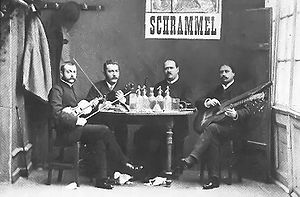
Wienerlied
Encyclopedia

The Wienerlied or Weanaliad (viennese
Viennese German
Viennese German is the city dialect spoken in Vienna, the capital of Austria and is counted among the Bavarian dialects. Even in Lower Austria, the state surrounding the city, many of its expressions are not used, while farther to the west they are often not even understood.- Linguistic...
, pl. Weanaliada) is a song genre which has its roots in Vienna
Vienna
Vienna is the capital and largest city of the Republic of Austria and one of the nine states of Austria. Vienna is Austria's primary city, with a population of about 1.723 million , and is by far the largest city in Austria, as well as its cultural, economic, and political centre...
, the capital of Austria
Austria
Austria , officially the Republic of Austria , is a landlocked country of roughly 8.4 million people in Central Europe. It is bordered by the Czech Republic and Germany to the north, Slovakia and Hungary to the east, Slovenia and Italy to the south, and Switzerland and Liechtenstein to the...
. Traditional Viennese songs, known as Wienerlieder are centred on the theme of life in Vienna and are almost exclusively sung in Viennese
Viennese German
Viennese German is the city dialect spoken in Vienna, the capital of Austria and is counted among the Bavarian dialects. Even in Lower Austria, the state surrounding the city, many of its expressions are not used, while farther to the west they are often not even understood.- Linguistic...
(a local Austro-Bavarian dialect). The Wienerlied is a unique musical and socio-cultural phenomenon, a psychograph of the Viennese way of life; a mix between idealism, joie de vivre and desperation.
There are approximately 60,000 – 70,000 Wienerlieder, of which only a few hundred are still sung today.
Characteristics
A distinguishing feature of many Wienerlieder is their chromatic and harmonic variety. Frequent changes in tempo together with theatrical pauses throughout the songs bring a certain degree of excitement to both singer and listener. A typical Wienerlied is written according to a 2/4 or 3/4 time signature with an often-alternated rhythm.The Wienerlied has a more complicated musical structure than other well-known music genres such as blues, rock, folk or Alpine folk music. It is therefore quite unusual that Wienerlieder became so popular, yet it is often the case that many songs become established as traditional folk songs in Vienna.
The Alpine-Bavarian roots of Wienerlieder are still recognizable; for example, the melody of ‘Landler’ (an Austrian folk dance featuring much hopping and stamping) or the characteristic use of melodic polyphony (a deep main voice sung together with a second accompanying higher-pitched voice). Slavo-Hungarian components are also recognizable within Wienerlieder, adding to the unique mix of multiple musical elements that give an exciting and surprising feel to Viennese folk songs. And all of this with a carefree wink and that typical Viennese ‘schmaeh’ (Viennese: “Weana Schmaeh”; German: “Wiener Schmaeh”) as characteristic as the folk songs themselves; a blend of humour built on quick-wit and charm and at times sarcasm and melancholy, but always expressed with a smile.
Roots
The characteristics of Wienerlieder can be defined through a variety of roots:- Street-song, hurdy-gurdy man
- Theatre couplets
- Art song, lied
- Songs of “Volksaenger” (popular entertainers of Viennese folk culture)
- Folk songs (Bavarian, Slavic, Hungarian)
- Operetta and Vaudeville
History
The Wienerlied reached its heyday in the 19th century, which is closely related to the rise of popular entertainment during the last quarter of the 19th century (inns and restaurants in the Prater gardens, nightclubs, Singspiel halls, "Heuriger" wine taverns, etc.). The development of Volkssaenger (popular entertainers of viennese folk culture) promoted the Wienerlied and several songs gained great popularity.Sources
- Most of the material in this article is from the Bavarian Wikipedia article Weanaliad.
Further reading
- Elisabeth Th. Fritz, Helmut Kretschmer (ed.): Wien Musikgeschichte. Teil 1: Volksmusik und Wienerlied. vol. 6. Lit-Verlag, Vienna 2006, ISBN 3-8258-8659-X.
- Jürgen Hein (Hrsg.): Wienerlieder. Von Raimund bis Georg Kreisler. [text collection], Reclam, StuttgartStuttgartStuttgart is the capital of the state of Baden-Württemberg in southern Germany. The sixth-largest city in Germany, Stuttgart has a population of 600,038 while the metropolitan area has a population of 5.3 million ....
2002, ISBN 3-15-018211-5 - L. Schmidt, Volksgesang und Volkslied, 1970; S. Lohr, Drum hab i Wean so gern, 1980.

